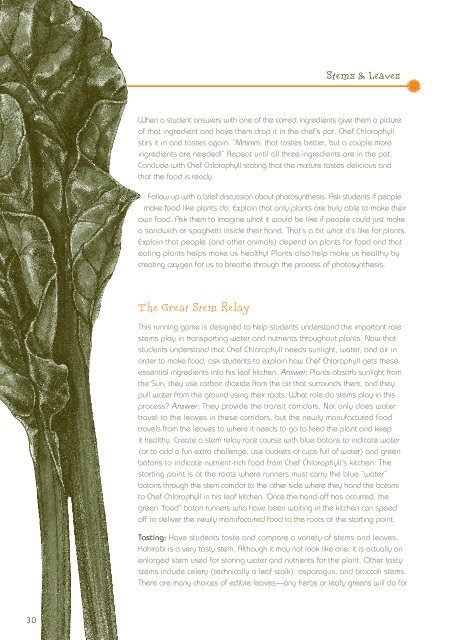Got Veggies? - Center for Integrated Agricultural Systems
Got Veggies? - Center for Integrated Agricultural Systems
Got Veggies? - Center for Integrated Agricultural Systems
Create successful ePaper yourself
Turn your PDF publications into a flip-book with our unique Google optimized e-Paper software.
Stems & Leaves<br />
When a student answers with one of the correct ingredients give them a picture<br />
of that ingredient and have them drop it in the chef’s pot. Chef Chlorophyll<br />
stirs it in and tastes again. “Mmmm, that tastes better, but a couple more<br />
ingredients are needed!” Repeat until all three ingredients are in the pot.<br />
Conclude with Chef Chlorophyll stating that the mixture tastes delicious and<br />
that the food is ready.<br />
Follow up with a brief discussion about photosynthesis. Ask students if people<br />
make food like plants do. Explain that only plants are truly able to make their<br />
own food. Ask them to imagine what it would be like if people could just make<br />
a sandwich or spaghetti inside their hand. That’s a bit what it’s like <strong>for</strong> plants.<br />
Explain that people (and other animals) depend on plants <strong>for</strong> food and that<br />
eating plants helps make us healthy! Plants also help make us healthy by<br />
creating oxygen <strong>for</strong> us to breathe through the process of photosynthesis.<br />
The Great Stem Relay<br />
This running game is designed to help students understand the important role<br />
stems play in transporting water and nutrients throughout plants. Now that<br />
students understand that Chef Chlorophyll needs sunlight, water, and air in<br />
order to make food, ask students to explain how Chef Chlorophyll gets these<br />
essential ingredients into his leaf kitchen. Answer: Plants absorb sunlight from<br />
the Sun, they use carbon dioxide from the air that surrounds them, and they<br />
pull water from the ground using their roots. What role do stems play in this<br />
process? Answer: They provide the transit corridors. Not only does water<br />
travel to the leaves in these corridors, but the newly manufactured food<br />
travels from the leaves to where it needs to go to feed the plant and keep<br />
it healthy. Create a stem relay race course with blue batons to indicate water<br />
(or to add a fun extra challenge, use buckets or cups full of water) and green<br />
batons to indicate nutrient-rich food from Chef Chlorophyll’s kitchen. The<br />
starting point is at the roots where runners must carry the blue “water”<br />
batons through the stem corridor to the other side where they hand the batons<br />
to Chef Chlorophyll in his leaf kitchen. Once the hand-off has occurred, the<br />
green “food” baton runners who have been waiting in the kitchen can speed<br />
off to deliver the newly manufactured food to the roots at the starting point.<br />
Tasting: Have students taste and compare a variety of stems and leaves.<br />
Kohlrabi is a very tasty stem. Although it may not look like one, it is actually an<br />
enlarged stem used <strong>for</strong> storing water and nutrients <strong>for</strong> the plant. Other tasty<br />
stems include celery (technically a leaf stalk), asparagus, and broccoli stems.<br />
There are many choices of edible leaves—any herbs or leafy greens will do <strong>for</strong><br />
30
















